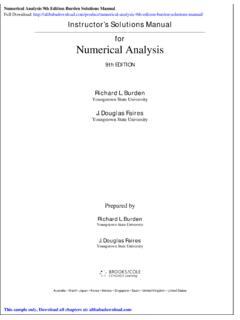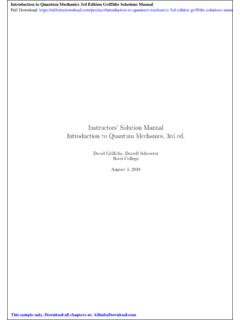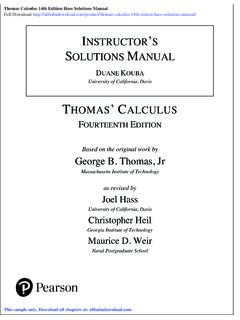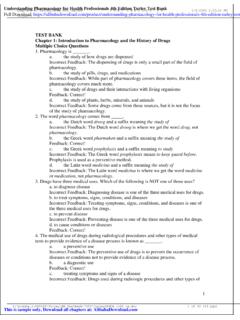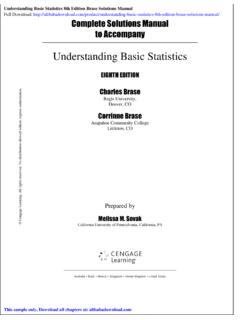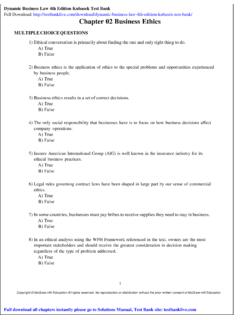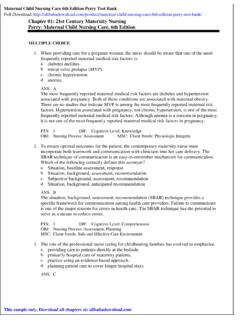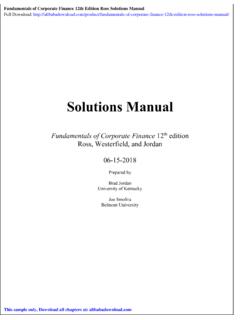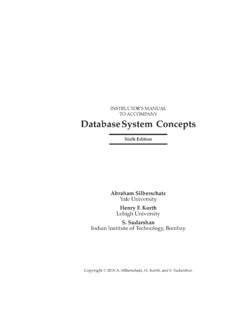Transcription of Fundamentals of Database Systems 7th Edition Elmasri ...
1 Fundamentals of Database Systems 7th Edition Elmasri Solutions Manual Full Download: Chapter 2: Database system Concepts and Architecture 1. CHAPTER 2: Database system CONCEPTS AND ARCHITECTURE. Answers to Selected Exercises - Think of different users for the Database of Figure What type of applications would each user need? To which user category would each belong and what type of interface would they need? Answer: (a) Registration Office User: They can enter data that reflect the registration of students in sections of courses, and later enter the grades of the students.
2 Applications can include: - Register a student in a section of a course - Check whether a student who is registered in a course has the appropriate prerequisite courses - Drop a student from a section of a course - Add a student to a section of a course - Enter the student grades for a section Application programmers can write a number of canned transactions for the registration office end-users, providing them with either forms and menus, or with a parametric interface. (b) Admissions Office User: The main application is to enter newly accepted students into the Database .
3 Can use the same type of interfaces as (a). (c) Transcripts Office User: The main application is to print student transcripts. Application programmers can write a canned transaction using a report generator utility to print the transcript of a student in a prescribed format. The particular student can be identified by name or social security number. Another application would be to generate grade slips at the end of each semester for all students who have completed courses during that semester. Again, this application could be programmed using a report generator utility.
4 - No solution provided. - if you were designing a Web-based system to make airline reservations and to sell airline tickets, which DBMS Architecture would you choose from Section Why? Why would the other architectures not be a good choice? Answer: Three-Tier Client/Server Architecture for Web Application is the best choice. The Client consists of Web User Interface. The Web Server contains the application logic which includes all the rules and regulations related to the reservation process and the issue of tickets; the Database Server contains the DBMS.
5 Centralized DBMS Architecture would not work since the user interface and Database server are on different machines for a web-based system . Basic Client/Server Architecture and Two-Tier Client/Server Architecture would work if the Business Logic can reside on server other than the DBMS Server. In general, if the business logic was on the DBMS Server, it will put an excessive burden on the server. If the business logic were to reside on the web client, it will burden the communication network as well a possibly thin client.
6 - Consider Figure In addition to constraints relating the values of columns in one table to columns in another table, there are also constraints that impose restrictions on Copyright 2016 Pearson Education, Inc., Hoboken NJ. This sample only, Download all chapters at: 2 Chapter 2: Database system Concepts and Architecture values in a column or a combination of columns within a table. One such constraint forces that a column or a group of columns must be unique across all rows in the table. For example, in the STUDENT table, the StudentNumber column must be unique (to prevent two different students from having the same StudentNumber).
7 Identify the column or the group of columns in the other tables that must be unique across all rows in the table? Answer: Table Column(s). COURSE CourseNumber Since this contains the combination of the department and the number that must be unique within the department. Note we will overlook the fact this does not accommodate a department from offering several Special Topics course with the same CourseNumber but different titles. We could make this a combination of CourseNumber and CourseName, but this is more succeptible to someone mistyping while entering data.
8 PREREQUISITE The combination of CourseNumber and PrerequisiteNumber SECTION SectionIdentifier We assume that no two sections can have the same SectionIdentifier. If we were to consider that SectionIdentifier is unique only within a given course offered in a given term (such as section 2 of CS101). then the answer changes to the combination of SectionIdentifier, CourseNumber, Semester, and Year. GRADE_REPORT StudentNumber and SectionIdentifier As per assumption stated in SECTION, the SectionIdentifier will be different if a student takes the same course or a different course in another term.
9 Copyright 2016 Pearson Education, Inc., Hoboken NJ. Fundamentals of Database Systems Laboratory Manual1. Rajshekhar Sunderraman Georgia State University August 2010. 1. To accompany Elmasri and Navathe, Fundamentals of Database Systems , 6th Edition , Addison-Wesley, 2010. 2. Preface This laboratory manual accompanies the popular Database textbook Elmasri and Navathe, Fundamentals of Database Systems , 6th Edition , Addison-Wesley, 2010. It provides supplemental materials to enhance the practical coverage of concepts in an introductory Database Systems course.
10 The material presented in this laboratory manual complement many of the chapters of the Elmasri /Navathe text typically covered in most introductory Database Systems courses. Chapter Mappings The laboratory manual consists of 8 chapters and the following table shows the mapping to the chapters in the Elmasri /Navathe textbook: Laboratory Manual Chapter Elmasri /Navathe 6th Edition Chapter(s). Chapter 1 Chapters 7, 8, and 9. Chapter 2 Chapters 3, 6, and 26. Chapter 3 Chapters 4, 5, and 13. Chapter 4 Chapters 4, 5, and 14.
